21 Aug Italy — Down on the Old River Styx
Back when the Underworld was in its glory days, a lot of people went to visit. Thetis, to dunk baby Achilles into the River Styx and make him invulnerable. Odysseus, to check in with Achilles after an arrow got him in the one part of his body Thetis neglected to dunk. Aeneas, seeking advice from his dad. Orpheus to rescue his dead wife. Herakles to steal, and then return, Cerberus, the three-headed dog that was the mascot of Hades. I wanted to go, too.
To Robert Paget, a British doctor working at a NATO base in Italy, there were just too many stories about too many visitors for the whole thing to have been made up. Not that he believed living people actually visited the Underworld. Just, that whatever had been going on smacked of a religious scam.
Visitors, at least mortal visitors, were given a sacred drink, probably laced with hallucinogens, then led by chanting, black-robed figures down a narrow, gloomy, passage. The air was hot, choking with fumes, and filled with the moans of the dead . . . also, the barking of a dog . . . until they reached the boiling River Styx. Paget set out to discover where this happened.
He narrowed the search down to the Phlegraean Fields, a caldera about an hour west of Naples reeking of sulfur, steam vents, and volcanic fumaroles. In the early 1960’s, he found what he was looking for: a complicated set of tunnels
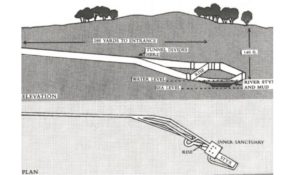
beneath the ruins of the Oracle of the Dead, a Greek Temple perched on the side of a cliff.
Using a long rope, he lowered himself into a passage that was eight feet high, twenty-one inches wide and uncomfortably hot. Hewn through solid rock the passage was narrow, gloomy, filled with choking fumes, and sloping downhill. Back in the day, it would have been made even spookier by oil lamps flickering in niches.
Five-hundred feet downhill, the passage widened into what Paget called the “Inner Sanctuary” set on the bank of a heated, volcanic river. Here, the niches became more frequent to provide light for ceremonies. A platform on the far side of the river provided a place for actors playing the roles of dead ancestors to give ambiguous answers to whatever questions had led the visitors underground in the first place.
Partway down the passage, Paget found pivots from an ancient door where a second passage split to the side. This allowed the actors to beat the paying customers to the river. It would also have been a good place to chain barking dogs. During Roman times, the side passage had been filled with what Paget estimated to be 30,000 man-loads or rubble. What had been back there . . . what was probably still back there . . . and why anyone would have gone to so much trouble to conceal it, was a mystery as spooky as anything else about the tunnels.
I learned about all this in the early Nineties and had been trying to figure out how to see for myself ever since. I mean, who wouldn’t want to jump into the River Styx and come out arrow and bronze-sword proof? Besides, I had some questions I wanted to ask my dad.
But the getting there wasn’t easy. The Italian government had locked the place up to keep people like me from inhaling the fumes and heading off to the Underworld for real. Then, a couple of years ago, I made contact with the Italian Speleo-archaeological society that holds the keys. Peggy and I joined the Society and, this summer, they held a three-day open-house for their overseas members . . . meaning Peggy and me.
Our first inkling that Paget may have overstated his results came when we arrived at the Oracle of the Dead. Instead of being a Greek temple perched on the edge of a cliff, it was part of a very high-end Roman villa.
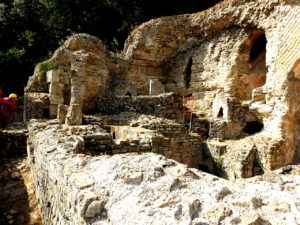
built on a set of terraces just uphill from the Emperor Claudius’s Nymphaem in what was the ancient resort town of Baiae, the villa had had a lot more to do with providing an ostentatious lifestyle than anything involving being dead.
Baiae was the Palm Beach of Ancient Rome where the uber-rich came to holiday and politicians disported themselves far from the disapproving gaze of their constituents. Given what’s happening to the weather nowadays, Baiae may be the Palm Beach of the future, as well, because Claudius’s Nymphaem has sunk to the bottom of the Gulf of Pozzuoli where, a few years ago, Peggy and I SCUBA dived across the tiled floor of his imperial bath.
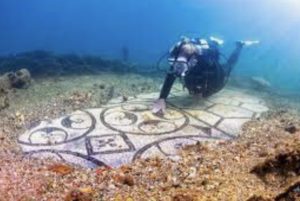
From the villa, we descended into the Underworld, not by dangling from a rope, but by climbing down an ordinary ladder.
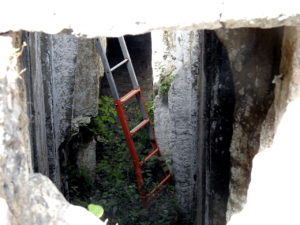
And not through a formal entrance, but through the collapsed roof of the passage itself. Which meant that, not only did the passage head down to the Underworld, it continued in the other direction to wherever it would have emerged inside the villa. Paget hadn’t been interested in that part, so it was still choked with mud.
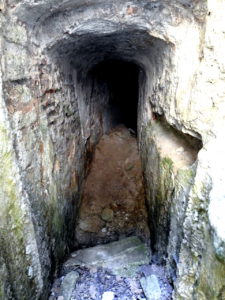
We headed into the hillside expecting fumes and overheated air, but it wasn’t that way. The air wasn’t hot, at least not by the standards of a July day in southern Italy. And there weren’t any fumes or poisonous gasses that we could detect. Still, given the fact that the passage had a corbelled roof,
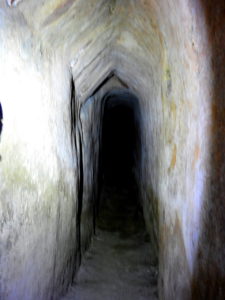
and that the true arch preceded the Roman Empire by almost six centuries, I couldn’t shake the feeling the tunnel may have actually hailed from the time of Odysseus.
When I pointed this out to the man from the Speleo-archaeological society, he pointed out the layer of hydraulic plaster lining the ceiling and walls and announced we were in a steam tunnel that supplied the baths at the villa. So, I told myself, still hoping for the best in the Passage-to-the-Underworld department, What could have been easier than plastering over an ancient Disney World to make a steam tunnel?
Wherever we actually were, Paget’s interpretation became harder to swallow when we arrived at the side passage. The “door” the actors had slipped through was a ragged hole about a square foot in size. And whatever was on the other side didn’t look intentionally filled with 30,000 basket-loads of rubble. It looked like the roof had fallen in.
The Inner Sanctuary would have been a disappointment, if there’d been an Inner Sanctuary. Where Paget’s diagram shows a rectangular space with five columns supporting some kind of subterranean portico opening onto the River Styx, in person it’s just another bit of passage, with no more sign of columns than any other bit of passage. Which was lucky for us because, with twenty-one inches to work with, we could never have squeezed by.
He was right about the niches for oil lamps, though. They’d become more numerous and, to this day, I can’t imagine what they would have been doing in a steam tunnel.
I’d brought along a couple of dozen battery-operated votive candles to place in the niches, wanting to see how the Underworld looked to ancient visitors.
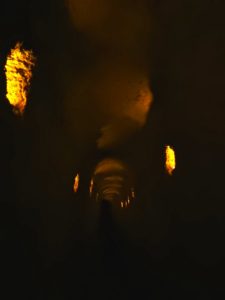
They gave enough light to pick our way along, but that was about it. It was hard to imagine how any ceremony could have been conducted in such a dim place. Even had it been broad daylight, the passage was so narrow that the only people anybody could have seen would have been the ones standing directly in front or behind them.
At this point, I’d imagined we’d be standing on the edge of a stream, maybe even a small river, and I’d come prepared with a bathing suit under my caving outfit. But there wasn’t any river. There wasn’t even a small stream. Just the passage continuing downhill until it reached the water table.
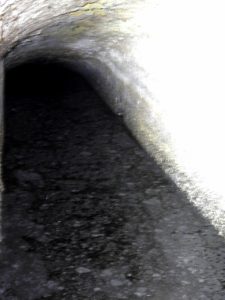
For all we could tell, we’d been exploring an ancient storm sewer.
There was no place to jump in and become invulnerable. Nowhere to kneel and dunk a baby. And no other side, so nowhere to discuss matters with Dad, which he probably took to be a relief. The water was cool to the touch and, in the end, I just just dipped in an arm. So, now, I have an invulnerable hand and wrist which I can use like Wonder Woman to swat away bullets.


No Comments